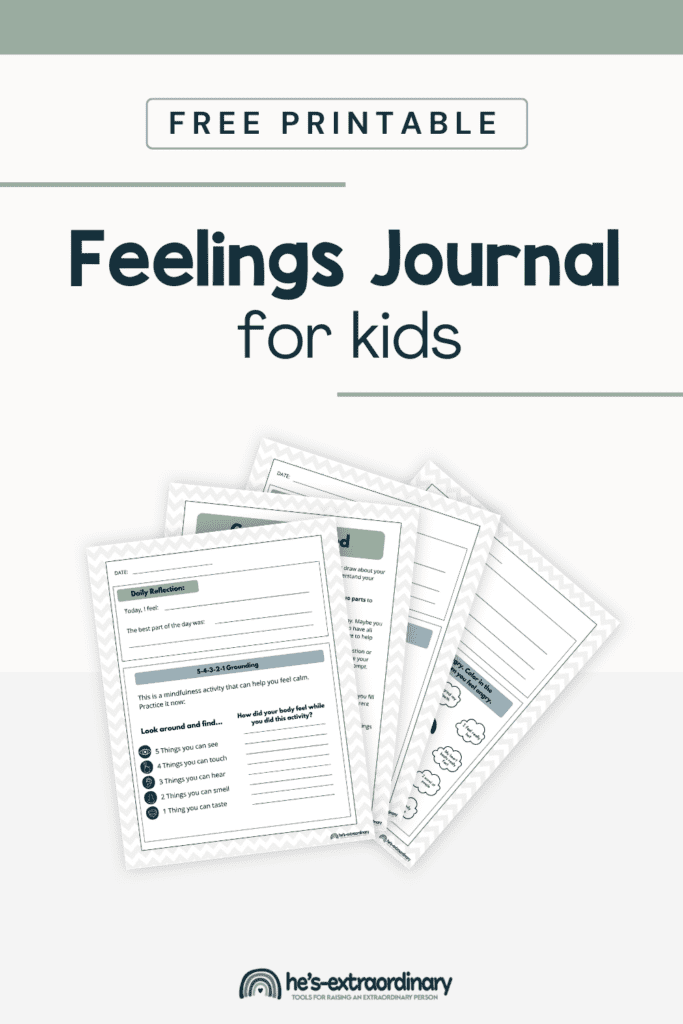How A Feelings Journal Can Help Kids Understand Their Emotions
What’s inside this article: A look at how a feelings journal can help kids identify and understand their emotions better. Includes a free printable feelings journal with two weeks of prompts.
We all experience a wide range of emotions, from joy and excitement to sadness and frustration. Helping kids identify, understand, and cope with these feelings is essential to their social-emotional development.
Kids who are able to identify what they’re feeling:
- Display fewer behavior problems
- Do better in school
- Are more empathetic and supportive of others
- Develop healthy coping skills and resilience
- Have a positive self-image
- Have positive and stable relationships with others
- Experience better mental health

Recognizing emotions comes naturally to many children, but it’s a big struggle for some kids.
Kids who can’t accurately identify their emotions:
- Have difficulty expressing themselves through words
- Experience increased frustration and outbursts
- Struggle to build healthy friendships
- Can’t seek help or support when feeling overwhelmed
- Have challenges recognizing and managing their own needs
- Show difficulty in perspective-taking and other social skills
- Struggle with adapting to new or unfamiliar situations
Luckily, many different tools are available that help them learn how to identify their feelings.
One tool to help your children learn about their emotions is a Feelings Journal. A Feelings Journal can assist kids in better understanding and managing their emotions.
Make sure you download the free printable journal at the end of the post!
What is a Feelings Journal?
A Feelings Journal, sometimes called an emotional journal, is a personal record where kids can express and explore their emotions on a regular basis through writing and drawing.
It provides a safe space for them to reflect on their feelings and gain a deeper understanding of their emotional world.
Why Use a Feelings Journal?
Using a Feelings Journal offers numerous benefits for children:
- Emotion Vocabulary Building: It helps kids learn to identify and name their emotions. I’ve included a Feelings Wheel in the printable journal to assist kids in expanding their emotional vocabulary. You can also find a list of emotions for kids here.
- Emotion Expression: Kids can express their feelings in words or drawings, building creative expression and communication skills.
- Emotional Awareness: Regular journaling encourages self-awareness by prompting kids to reflect on their daily emotions and experiences.
- Emotional Regulation: By acknowledging their emotions in the journal, kids can learn to manage their feelings healthily and constructively.
- Positive Self-Image: Reflecting on positive experiences and achievements helps boost self-esteem and confidence.
- Stress Reduction: Journaling can act as a therapeutic tool, offering a safe space for kids to express pent-up feelings and relieve stress.
- Problem Solving: By regularly documenting their feelings, kids may find it easier to identify solutions to emotional challenges. Seeing your thoughts on paper can make them easier to manage and can provide clarity on issues that might seem overwhelming.
- Track Progress and Patterns: A feelings journal can be a helpful way to track feelings over a period of time, helping you to see how your emotional state changes and develops. Kids may be able to identify certain patterns in their emotional responses that are tied to specific activities, times of day, or interactions (with the help of an adult).
How to Use a Feelings Journal:
Here’s a simple guide on how kids, with the help of their parents or teachers, can use the Feelings Journal effectively:
- Download the Free Printable: Download and print the free printable Feelings Journal. It includes instructions, a Feelings Wheel, and two weeks of daily journal entry pages.
- Introduce the Journal: Explain the purpose of the journal to your child. Let them know it’s a special place for exploring and understanding their feelings.
- The Feelings Wheel: Explore the Feelings Wheel together. Discuss the different emotions and ask your child to identify which ones they have felt recently.
- Daily Journal Entries: Encourage your child to make daily journal entries. Each entry has two parts – a daily reflection, which is always the same, and a unique journal prompt.
- Review and Discuss: Periodically review the journal entries with your child. This can help you better understand your child and how they think. It also allows you to talk about some of the different feelings they’re writing about.
- Problem-solve together: If your child faces any difficulties with the journal prompts, brainstorm responses or practice the activities together.
A Feelings Journal is a fantastic tool for kids to explore, understand, and cope with emotions. It promotes emotional intelligence and provides a structured way to build their emotional vocabulary.
Get started by downloading the free journal below:
Feelings JournalMore resources for helping children understand feelings:
- Free Printable Feelings Wheel for Kids
- List of Emotions for Kids
- Books about Emotions for Kids
- How Do I Feel? Emotions Booklet
- Understanding and Coping with Feelings – Printable Mega Bundle


